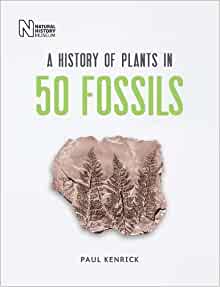A History of Plants in 50 Fossils
By Paul Kenrick

This book would seem to be the follow up to the well-received A History of Life in 100 Fossils. However, this time, this glossy hardback tells the story of plants on earth using significant fossils that are, for the most part, kept at the Natural History Museum in London. Like that other book, it is set out in a simple format, in which a couple of sides of text are used to describe a full page colour photograph of the fossil in question.
A History of Plants in 50 Fossils begins with the origins of plant life in the sea, billions of years ago, when bacteria started to photosynthesize for the first time and the atmosphere was changed forever. Oxygen began to be produced in large quantities and the Earth went rusty, leaving behind the banded iron formations, so essential for modern industry. The book then traces the evolution of plants, through ancient forests and grassland to the flowering plants of today.
The fossils covered consist of everything from petrified tree trunks to grains of pollen. And it is clear that the breath of the palaeontological record of plants is extraordinary. In fact, what emerges from this book is that plants forms are both puzzling and often extremely beautiful. Each photographed specimen has a story to tell, which is explained in the context of the Earth’s landscapes and environments throughout geological time. In this way, the book reveals the dynamic feedback between plants and animals, (and, in the case of the banded iron) large-scale planetary processes.
Of course, the book could be read from cover to cover to discover how these remarkable fossil discoveries illustrate how life on earth has evolved. However, it can also be enjoyed by dipping in randomly, as each of the 50 sections is self-contained.
As I said of A History of Life in 100 Fossils, I wouldn’t buy this book if you want to identify your fossils. Those of us who like to collect can only dream, in our wildest fantasies, of finding anything like the fossils appearing in this excellent and colourful book. However, if you want to see how fossils have driven our understanding of plant life on earth, this one is for you.
Paul Kenrick is a research scientist at the Natural History Museum in London. His research focuses on the early evolution of plants during the Palaeozoic Era and their crucial roles in the development of life on land. He is also fascinated by the floras of the Mesozoic Era and how plants and dinosaurs might have co-evolved. He has written over 70 scientific papers and two books on plant evolution.
A History of Plants in 50 Fossils, by Paul Kenrick, Natural History Museum, London (200), 160 pages (hardback), ISBN: 978-1-565-094850-0